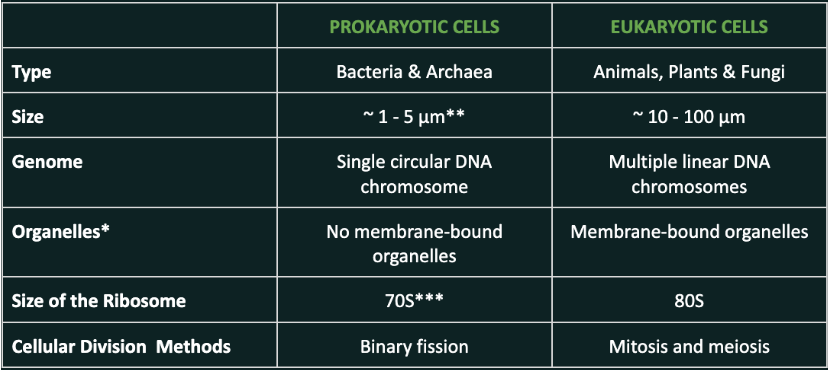The two main types of cells: Prokaryotes and Eukaryotes
- Renard

- Dec 15, 2022
- 3 min read
As mentioned in the last text, there are billions of different cells - from the bacteria in the soil to the various cells that create the human body. They can be classified into prokaryotic cells (bacterias and archaeas) and eukaryotic cells (animal, plant, fungi, and protists) depending if they have a well-defined nucleus or not [1].

Organelles of Prokaryotic and Eukaryotic cells [2].
Similarities
At the most basic level, a cell is essentially composed of a cell membrane and its enclosed interior is known as the cytoplasm. The cell membrane is bilayer, meaning that it consists of two layers of lipids (like fats and oils). The membrane also serves to protect the interior of the cell from the external environment and regulates the transport of materials [3]. Finally, the cytoplasm contains different biomolecules and performs the processes of life that the cell needs for growth and division [4].
Moreover, in some cells, the plasmatic membrane is surrounded by a cell wall that provides structural support and rigidity [5,6]. The cell wall is made of different components in bacteria (peptidoglycan), archaeas (other components but no peptidoglycan), plants (cellulose), and fungi (chitin) [5-7].
Finally, even though ribosomes in prokaryotes and eukaryotes differ in size, their function is the same. These structures made possible the translation of mRNA to protein [8] (more information in this text).
Differences
The distinction between these groups is based on how they protect and store their genetic information. Prokaryotic cells do not have a special compartment to store their genetic information, whereas eukaryotic cells have developed a special structure - known as the nucleus - to house the majority of their genetic material. In addition, eukaryotic cells tend to be larger in comparison to their prokaryotic brethren. Finally, eukaryotic cells have evolved multicellularity, meaning that multiple cells can team up to create one organism, whereas prokaryotic cells are always unicellular (more information in the last post). Below there is a table with the most significant differences between the two groups.


Fig 1. Example of prokaryotic cell (unicelullar bacteria Escherichia Coli) [9]

Fig 2. Example of eukaryotic cell (plant cells forming a plant leaf) [10]
Stay tuned for the next series where we will describe the function of each structure in the eukaryotic cell and the amazing nucleus!
*Organelles: cell structures that carry out specific functions.
*μm: The micrometer (μm) is a measurement of length equal to one millionth of a metre or one thounsandth of a millimetre.
*S: The “S” stands for Svedbergs, a unit used to measure how fast molecules move in a centrifuge.
—-----------------------------------------------------------------------------
Written by: Renard
Edited by: María and Natasha
BioDecoded is a volunteer group committed to sharing accurate scientific information. If you have any questions about this topic or would like to learn more, please comment below or send us your questions.
References:
Structure and types of cells (2022). Encyclopedia Britannica. Available at: https://www.britannica.com/summary/cell-biology (Accessed: 7 December 2022).
Mukherjee, S. Prokaryotes vs. Eukaryotes: Definition and Characteristics (2021). Science Facts. Available at: https://www.sciencefacts.net/prokaryotes-vs-eukaryotes.html (Accessed: 12 December 2022).
Cell Membranes | Learn Science at Scitable (2022). Available at: https://www.nature.com/scitable/topicpage/cell-membranes-14052567/ (Accessed: 12 December 2022).
Cytoplasm | Learn Science at Scitable (2022). Available at: https://www.nature.com/scitable/definition/cytoplasm-280/ (Accessed: 12 December 2022).
Cell wall - Proteins (2022). Encyclopedia Britannica. Available at: https://www.britannica.com/science/cell-wall-plant-anatomy/Proteins (Accessed: 12 December 2022).
Dörr, T., et al. (2019) "Bacterial Cell Wall Structure and Dynamics". Frontiers in Microbiology, 10. Available at: https://www.frontiersin.org/articles/10.3389/fmicb.2019.02051/full
Archaea - Characteristics of the archaea (2022). Encyclopedia Britannica. Available at: https://www.britannica.com/science/archaea/Characteristics-of-the-archaea (Accessed: 12 December 2022).
Ribosomes (2022). LibreTexts. Available at: https://bio.libretexts.org/Bookshelves/Microbiology/Book%3A_Microbiology_(Boundless)/4%3A_Cell_Structure_of_Bacteria_Archaea_and_Eukaryotes/4.6%3A_Specialized_Internal_Structures_of_Prokaryotes/4.6A%3A_Ribosomes (Accessed: 12 December 2022).
E. coli: What is It, How Does it Cause Infection, Symptoms & Causes (2022). Cleveland Clinic. Available at: https://my.clevelandclinic.org/health/diseases/16638-e-coli-infection (Accessed: 15 December 2022).
Specialised plant cells (2022). Bitesize. Available at: https://www.bbc.co.uk/bitesize/topics/znyycdm/articles/z2vrr2p (Accessed: 15 December 2022).




Comments